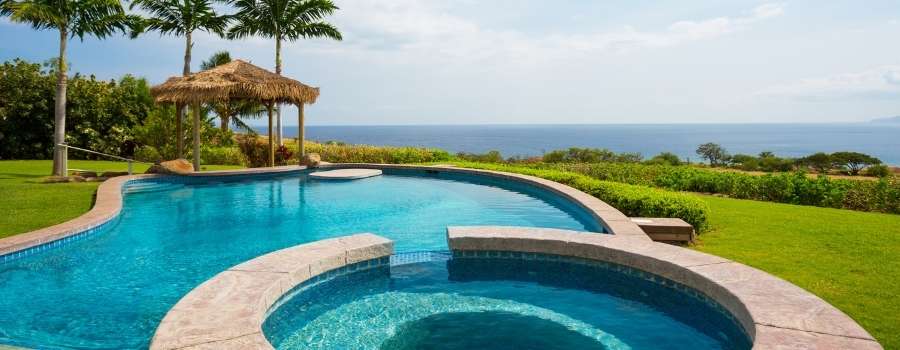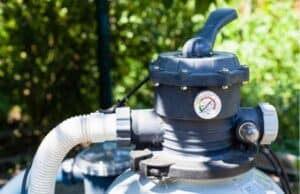
Swimming pools make for an excellent feature in any backyard. Unfortunately, a pool that operates continually does end up consuming a significant amount of electricity. To cut down on energy costs, homeowners might want to consider how to run a pool with solar power.
To run a pool with solar power, you’ll need to connect a home solar energy system to the pool’s water pump and filter. You can also use the same system to power a solar swimming pool heater as well if you live in colder climates or just prefer swimming in a heated pool.
In the following sections, we’re going to explore everything there is to know about how to run a pool with solar power right in your backyard. By the end of the article, you’ll see how a home solar-powered pool system might look like.
What Are The Parts Of A Pool System?
Firstly, let’s briefly go over the different parts of a pool system. This is an important thing to understand because not all of your pool’s components require your solar energy system’s electrical power.
An average backyard pool includes:
- The swimming pool.
- A pool filter (e..g sand or cartridge filter to keep the water clean).
- A pool pump (to drive water from the pool through the filter and back into the pool).
- A swimming pool heater (in some cases).
When all of those parts are in place and working correctly, the pool will be safe, clean, and comfortable for you and your family to enjoy.
Which Parts Of A Pool System Require Electricity?
As you might have guessed from seeing the list above, the swimming pool pump and heater are the only parts of the system that require electricity. Those are the parts that your solar energy system will need to supply power to.
How To Hook Up Solar Panels To A Pool Pump
Suppose your home already has a solar power system. If that’s the case, then all you’d need to do is connect the swimming pool pump and heater to that system. Of course, you would have to check to ensure that the solar system can accommodate the additional energy demands.
However, if you’re interested in putting together a solar energy setup to power your pool, here are the most essential components you’ll need to get started:
- Solar panels.
- Charge controller.
- Inverter.
- Swimming pool pump.
- Optional: Swimming pool heater.
Here’s how each of those components plays a role in running your pool with solar power:
Solar Panels
The photovoltaic (PV) panels, which most people just call ‘solar panels’, are where all the sun’s energy gets collected. Typically, these are mounted on your roof where it can get the most exposure to sunlight throughout the day. If, however, you have a large open area near your pool, it’s also possible to mount solar panels onto the ground as well.
These solar panels will only generate electrical energy for as long as they receive direct sunlight.
Charge Controller
A charge controller is a critical part of any home solar energy system. It works to regulate the voltage and current that flows through the system. If your solar energy system has batteries, the charge controller will ensure that the batteries never become overcharged.
Inverter
The electricity that’s generated by solar panels comes in the form of direct current or DC energy. However, many home appliances require alternating current instead. To convert the solar panels’ output from DC to AC, your home solar energy system will require an inverter.
Bear in mind that pool pumps are available in both AC and DC versions, depending on the brand and model that you choose.
Swimming Pool Pump

Here’s the part that we’re trying to power: the swimming pool pump. Inside the pump are a motor and an impeller that works to draw water from the pool and run it through one or more filters.
In doing so, the filter can remove any debris, dirt, and other impurities from the water before resupplying it to the swimming pool.
The end result? Your pool stays clean, safe, and enjoyable for as long as the pump is running.
Optional: Swimming Pool Heater
Some people prefer swimming in warmer water. If you live in a warm climate, that shouldn’t be a problem. However, homeowners living in colder climates may want to invest in a swimming pool heater.
The function of a swimming pool heater is pretty straightforward. Once the water has passed through the filter to be cleaned, it’ll also pass through a heater that raises its temperature. Then, the water flows back into the pool and keeps it warm enough to swim in comfortably.
Do You Need A Solar Battery To Power A Pool Pump?
Remember, a solar energy system will only generate electricity when the solar panels are exposed to direct sunlight. In this case, that means your solar-powered pool pump and heater will only be able to function when the sun is up and not on cloudy days or at night.
Suppose you’d like to enjoy your pool no matter what the weather or the time of day might be. If that’s the case, then you’ll need to add batteries to your home solar energy system.
With solar batteries, the system will be able to store energy that you can use to power your pool pump and heater no matter what the weather might be, and even so at night.
How To Heat A Pool Using Solar Power
When it comes to heating up a swimming pool using solar power, there are two approaches that you can take:
- Using a home energy solar system to power an electric pool heater.
- Using non-electric solar collectors to heat up the pool water.
Electric Pool Heater
Heating up your pool using an electric pool heater is pretty straightforward. As part of the swimming pool’s system, the pump will draw water from the pool and drive it through the filter. Once it’s clean, the water will then go through a heater which will raise the temperature of the water before it flows back into the pool.
Seeing as how this type of heater is powered by electricity, it’ll be connected to the home solar energy system that was mentioned above. Much like the pool pump, the solar-powered heater will not work during cloudy days or at night.
That is, of course, unless the solar power system has batteries that can supply energy during those times of the day.
Non-Electric Pool Heater
Another method to heat up a swimming pool is with ‘solar’ pool heaters. But don’t let that word fool you, there’s no electricity being generated or used to raise the pool’s water temperature.
Once the pool water is filtered, it’s then pumped through solar collectors. From a distance, these look almost the same as regular solar panels. Yet, even though the panels do collect sunlight, they don’t use it to generate electricity, but they use it to heat up all of the water that passes through them.
Once the water has passed through the solar collectors, its temperature is much higher than it was before. The water flows back into the pool, which is now much hotter than before.
Final Thoughts
As you can see, running a pool with solar power is an excellent way to cut down on your energy bills. Simultaneously, you can use solar energy to power a pool heater to enjoy a much more comfortable swim.
When you include a battery in the solar energy system, you’ll be able to run your pool pump and heater day and night, even when there’s no direct sunlight available.
